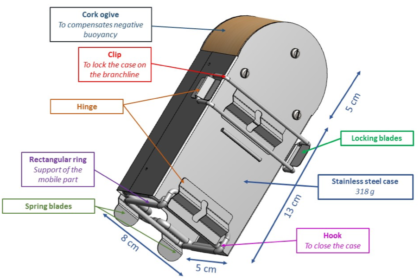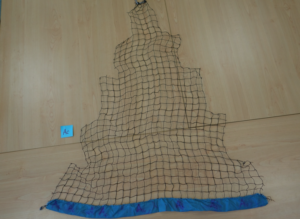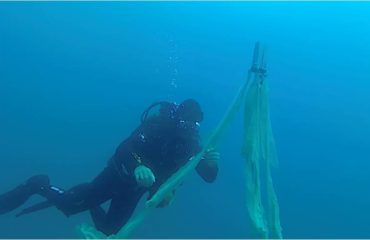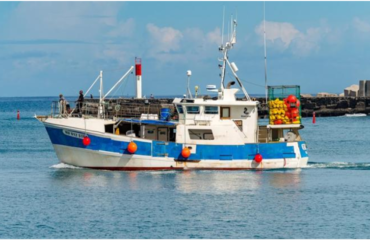
The third version of the device was tested in July 2020. It was conceived based on the observations raised during the previous experiments. This version is intended to be the final one that will be tested in real fishing conditions on pelagic longline vessels in Reunion Island. This version is made up of: 1) a fixed steel case set on the branchline, 2) and a mobile part simulating a cast net attached to a rectangular carabiner.
- Description of the device
- The case
The parallelepiped stainless case was equipped with a ribbed cork at its top, allowing to compensate for the negative buoyancy of the device under the water. This dome part enhances the device hydrodynamics while it is being hauled. The device size (8cm*5cm*18cm) is intended to ease its handling by the fishermen.
The case is attached to the branchline by using locking blades. The branchline is inserted into the case through a slot located on the carabiner, which is placed at the bottom of the case. The bottom part of the case is closed by a hook that locks onto two spring blades.

- The cast net
The net is made up of two pyramidal pieces cut out from a high-density polyethylene (HDPE) net. The HDPE net has several benefits: low cost, light weight, strength and rot-proofness despite prolonged immersion in sea water. In addition, the net provides a good visual coverage and a low entanglement rate.
The device is triggered when the hooked fish pulls on the branchline, resulting in the unlocking of the spring blades and then the release the net. The carabiner slides along the branchline to the fish.

- Survey protocol
The experimental tests of the V3 “PARADEP” device were carried out during a day at sea in July 2020. The experiments were carried out aboard an 11-meter boat, lent by the diving club Odyssée (http://odyssee-sub.org/). Data related to the device behavior were collected from video footages recorded by three divers.
On a 35 m long experimental mainline, 6 short branchlines equipped with the devices were deployed. Once the line and the devices were set, three divers equipped with underwater cameras went into the water. For each prototype, the diver (A) triggered the device by pulling on the branchline to simulate a capture. The diver (B) recorded the triggering and the descent of the device until the net deployment around the fish. The diver (C) recorded the whole experiment to provide a global view of it.
At the end of these tests, the video footages were analyzed and several data were collected: setting of the device on the branchline, its deployment (opening of the case, descent along the branchline, deployment of the nets during the descent, entanglement of the nets if observed), fish protection and storage easiness.
- Results
– The small size of the case allows a good grip and its behavior in the water is satisfying. The issues were mostly related to the hanging and opening systems. The clip intended to attach the case on the branchline was not tight enough.
– The rectangular carabiner will need to be changed into a circular carabiner with an opening and closing system. This would prevent its entanglement with the nets or the exit of the branchline.
– The behavior of the nets was disappointing. They were too bulky and could not get out of the case on their own during the simulation of a capture, so they had to be taken out manually. For the final device, it will be necessary to work with less bulky nets.
This version is certainly close to the expected final version. Some changes are still required:
- Turn the rectangular carabiner into a circular one
- Reinforce the locking blades
- Identify the adequate net for the cast net
- Add some stainless metal wires on the nets to improve its rigidity and provide a passive acoustic protection skill
The improved case was received in December 2020. The adequate net was also identified. A preview of the case behavior and the cast net can be seen below:
Due to the COVID 19 crisis, the validation tests of the prototype are on hold and will be carried out as soon as the sanitary conditions allow them.





